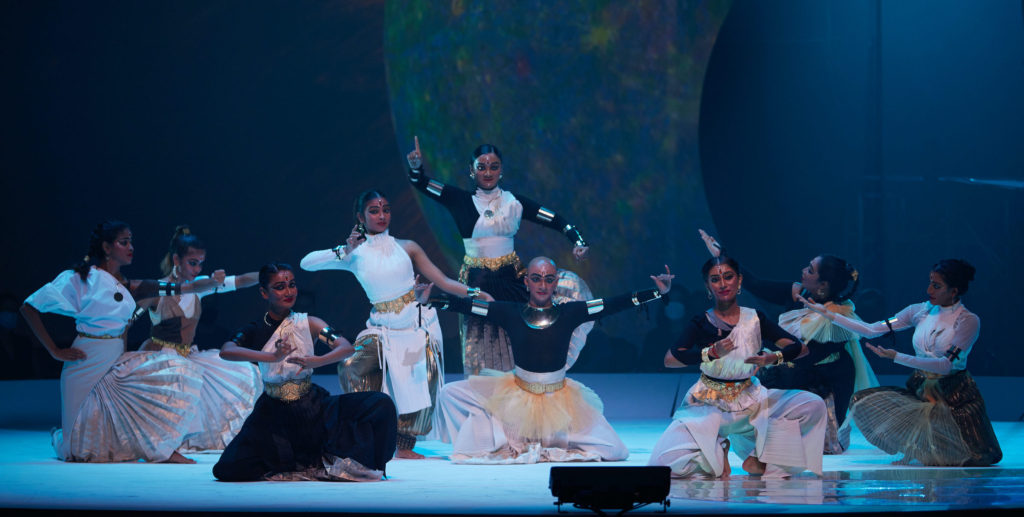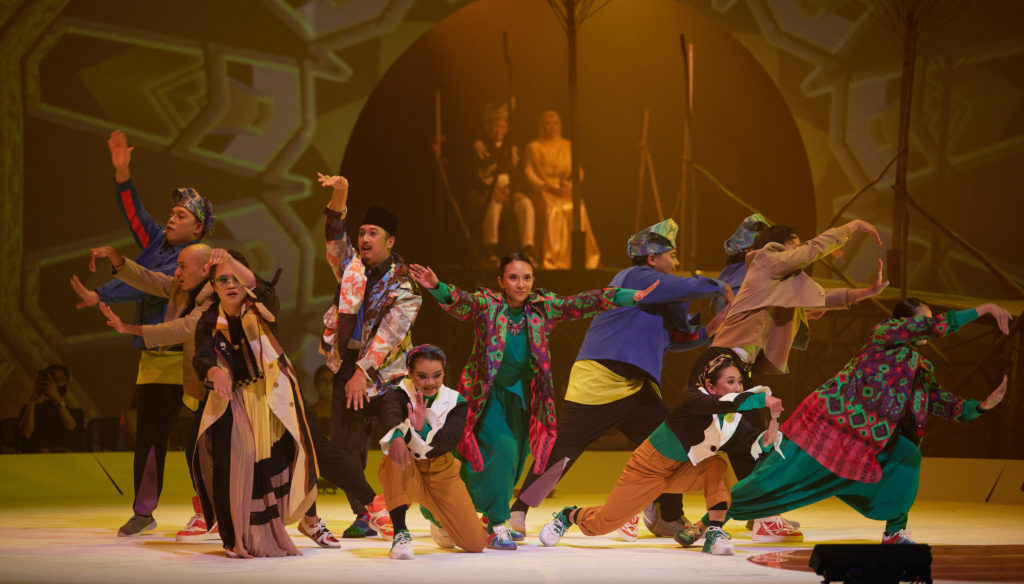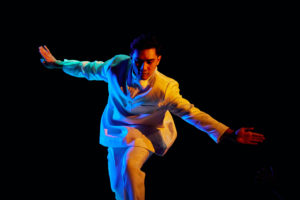Singapore: Taxi-dance halls, celestial bodies and wedding celebrations - Vancouver Ballet Society
- Home
- City Reports 2020 - 2023
- Singapore: Taxi-dance halls, celestial bodies and wedding celebrations

By Malcolm Tay
The easing of pandemic restrictions from March spelled good news for live shows, even if sitting shoulder to shoulder with still-masked strangers felt shocking at first. In May, viewers entered the Esplanade Annexe Studio for The Wrong Geng 2.0 suddenly free to claim any spot among the folding chairs surrounding three cylindrical platforms, like guests choosing a table at a nightclub.
Presented as part of Pesta Raya — Malay Festival of Arts, The Wrong Geng 2.0 is the second version of a solo that dancer-choreographer Norhaizad Adam premiered in 2018. Its title is a riff on ronggeng, a traditional music-dance genre that may have had roots in ancient Java. In Singapore, the term is also associated with the ronggeng clubs or taxi-dance halls in the entertainment parks of the 1930s–1960s, where male patrons could buy a coupon for a turn with a female partner.

Owing to the transactional nature of this activity, the women employed there were often thought to be sexually liberal, a stigma that eventually led to ronggeng being known by another name, joget. According to the program notes, joget “has been sanitised and modernised” and now “it is practiced as a respectable Singapore Malay dance form.”
This was indeed the image that concluded the piece, with Norhaizad formally dressed in a white long-sleeved shirt with matching pants, a knee-length brocade sarong, and a black brimless hat. Along the way, he provided a sense of how joget is performed today — the torso largely upright, arms angling or extending to the side with clenched fists (women’s hands would be styled differently, their fingers gracefully curled), feet shuffling in a double-step heel-toe pattern — its qualities magnified when rendered up close on a platform.
This was in blunt contrast to the opening, which saw Norhaizad in a pair of black vinyl shorts. He danced differently, too, unfurling and twisting the steps and shapes of joget as he snaked and burrowed through space to a pulsating score by sound designer Bani Haykal. Before leaping from one platform to another, he pointed his index finger at the audience — a bold gesture in light of its impropriety in Malay culture.
Norhaizad’s undulating, offbeat take seemed to pay tribute to the kind of joget that would have been done in the taxi-dance halls of yore, which tried to keep their clientele returning by absorbing other styles of dance and music that were trendy at the time. He also evoked the business-like pragmatism of these venues when he made several droll attempts to canvass viewers for cash as a rapid ticking track punctured the air.
Toward the end, Norhaizad handed out the collected money to a few spectators, giving back as it were to the community. In wittily visualizing the connection between time, work, and remuneration, The Wrong Geng 2.0 drew attention to the fact that time is especially short in a dancer’s career and that despite all the starry-eyed platitudes about dancing, it remains at heart an act of labour and should be recognized as a legitimate job.

A week earlier at the Esplanade Theatre, the Singapore International Festival of Arts premiered a trio of local commissions as a full-evening production. Ceremonial Enactments showcased three disparate responses to the festival’s theme of ritual, all taking place on a striking set by architect Randy Chan — a long ramp on wooden stilts linking the stage to a circular portal and the stalls.
Two performers in fluttery white jackets served as unearthly agents ushering each segment into being, a device that did not make the triptych as seamless as it was billed. Oddly, Ceremonial Enactments began with a fashion show dabbling with childbirth and death motifs: designer Max Tan’s ANG, whose title refers to his mother’s maiden name and to the Hokkien word for red.
The third section was notable for containing the final choreography of Santha Bhaskar, a pioneer of Indian dance and the former artistic director of Bhaskar’s Arts Academy. Before passing away in February at the age of 82, she had finished two parts of Yantra Mantra, an obeisance to the deities of the planets and the guardians of the nine directions of space according to Hinduism. Her daughter Meenakshy Bhaskar filled in the gaps, merging both their visions in a suite of shimmering, cosmos-inspired dances yearning for goodwill and blessings from the divine.

The middle act was the most engaging. In 293° NW, percussion ensemble Nadi Singapura (roughly translated as “pulse of Singapore”) muses on the traditional Malay wedding as not only a communal celebration but also a spiritual one (the title denotes the direction of Islam’s holiest site, the Kaaba in Saudi Arabia, faced by Muslims in Singapore during prayers). The cast rousingly recreated a groom’s procession toward his bride, including the customary banter between the groomsmen and bridal party.
Interwoven with the procession were songs of love and praise, ebullient drumming with various instruments, and passages of convivial group dancing. Briefly, Malay dance steps were leavened by the loose swagger of hip-hop, with a double-bass player changing into a beatboxer. The soaring melismatic vocals of Idawati Arman, bringing to life melodious poems about marriage, completed this expressive union of action and sound.

